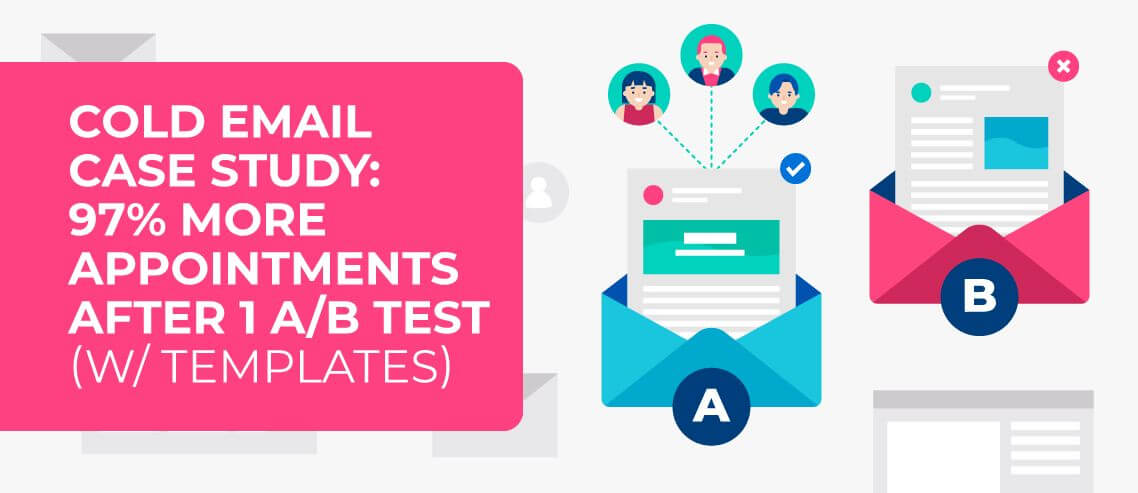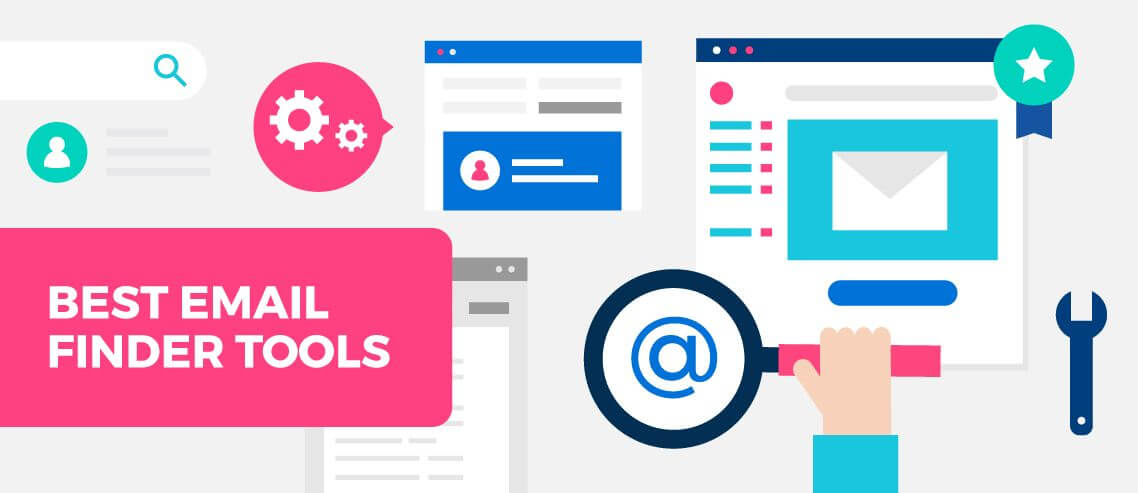How to Write a Follow-up Email After No Response

Contents
If the thought of writing a follow-up email makes you feel a little uncomfortable, you’re not alone. Our instincts tell us that if someone hasn’t replied to our first email, they’re not interested, and that they’re not going to like it if we bother them again.
Unfortunately in this case, our instincts are often wrong. Very few prospects say “yes” to the first ask – or, for that matter, to the second, third, or fourth.
In fact, a study from Iko System saw an 18% response rate to the first email they sent, and 13% to the fourth. The sixth email in the sequence received a massive 27% response rate.

A similar study from Yesware saw a 30% response rate to the first email and 14% to the fourth. They actually sent 10 emails in total and even the very last one had a 7% response rate.
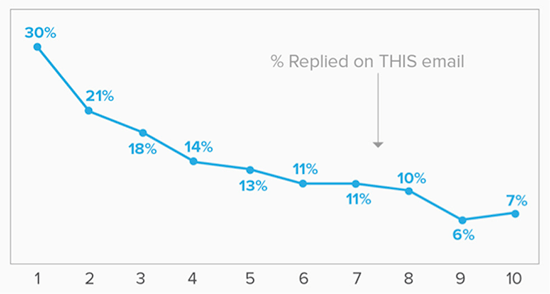
Despite this, Yesware reports that a colossal 70% of email chains stop after just one unanswered email.
It gets worse, or better, depending on how you look at it: Roughly 80% of prospects say ‘no’ four times before they ultimately say ‘yes’.
But 92% of people give up after hearing ‘no’ four times.
So, why does that matter? It means that only 8% of salespeople – those following up at least five times – are generating 80% of all sales.
Furthermore, other studies reveal that an email drip series with 4-7 messages delivers 3x more responses than those with only 1-3 (27% and 9%, respectively).
In fact, even following up just once can convert 22% more replies.
Needless to say, sending follow-up emails is essential (unless you like missing out on sales…)
“You can’t follow up too much in the earlier part of an engagement.” ~Damian Thompson, Leadfuze
Need some tips? Here’s how to write a follow-up email after no response.
- How Long Should You Wait Before Following Up?
- Automate Your Follow-Up Sequence
- Diversify Your Channels
- Decide What You Want to Achieve
- Put Yourself in Their Shoes
- How to Write a Follow Up Email
- Sales Follow-up Email Templates
- Expert Tips
Ready to take your follow-up game to the next level? Mailshake can help you send automated, personalized follow-ups at scale. Click here to learn more.
First, let’s answer this question…
How Long Should You Wait Before Following Up?
The short answer here is “not long.” The vast majority of emails are opened the day they’re sent, and if the recipient’s going to reply, they’re probably going to do that the same day, too. That means it’s pretty safe to assume that if someone doesn’t reply the day you send your email, they’re not going to reply at all.
How safe? About 90% of recipients open and reply – if they’re going to reply – on the day they receive an email.
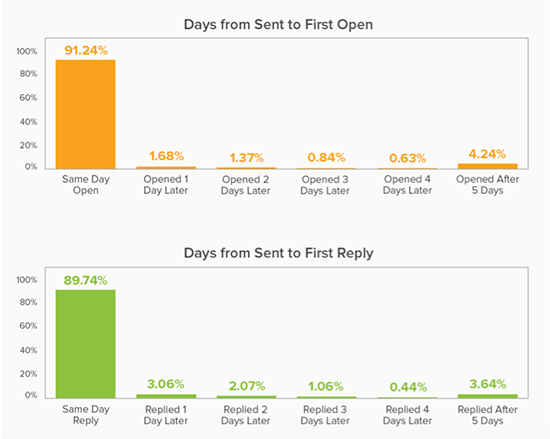
So, how long should you wait before sending a follow-up email?
As a general rule, two or three days is a good amount of time to wait before sending your first follow-up email. You should then extend the wait period by a few days for each subsequent email.
While there are no hard-and-fast rules on how you should approach this, Close.io CEO Steli Efti proposes spacing your follow-up emails like so:
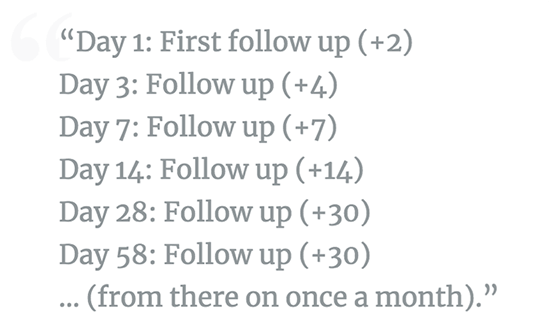
You can and should experiment, but that schedule is as good as any until proven otherwise. You want to follow up without annoying your targets with daily blasts. Efti’s suggested timetable works out to six emails – the initial contact and five follow-ups – over the course of a single 30-day period.
With it, you’re checking all the right boxes. Go with that until, if, and when you discover it’s not working for you and your audience.
Setting Up for Success
Okay, so you know why it’s important to follow up, how long to wait, and have a ballpark figure on how many messages to send altogether.
Before you start, though, you need to set yourself up for maximum success. The first step? Write it all down.
Writing down your goals and workflows is beneficial on many fronts: it creates consistency amongst everyone on your team, it keeps everyone on the same page, and it actually helps you achieve your goals better than if you didn’t write them down.
To maximize your follow-up success, have a concrete set of ‘rules’ as to time, frequency, quantity, and message. Be consistent. And automate.
Automate Your Follow-Up Sequence
If you’re reaching out to hundreds of prospects every week, it’s impossible to manually stay on top of following up with all of them.
That’s why a sales engagement tool like Mailshake is essential to creating an effective, scalable follow-up email sequence.
With Mailshake, you can personalize your emails in bulk with powerful mail merge features, schedule follow-up emails that are paused or triggered based on whether a a recipient opens an email, clicks a link, or replies, and reply to leads straight from your Mailshake dashboard with Lead Catcher.
You can also set the amount of time between follow-ups (5 days between the first and second email, 7 days between the second and third, etc.), and the days and times you want them to send (for instance, between 8 am and 6 pm on weekdays).
[lyte id=”XkdjhruF77s” /]
Optimize your copy and overall outreach strategy by AB testing different subject lines, body copy, and full campaign sequences. And with native integrations to your CRM, and third party integrations to hundreds of software tools via Zapier, you can automate your outreach even further by triggering campaigns when someone downloads an eBook, books a meeting, or signs up for a demo.
If social media and phone are a part of your outreach cadence (keep reading to find out why you should be), you can include those touch points in your outreach cadences as well with Mailshake Sales Engagement.
Bottom line: following up is absolutely essential to an effective outreach strategy, but there’s no reason why you can’t automate it.
Diversify Your Channels
Another key component that separates those killing the follow-up game from those just going through the motions is an omni-channel approach.
Yes, email is your best bet and the preferred channel for communication overall. But that doesn’t mean the other channels aren’t worth the effort.
“To me, social isn’t a ‘Should I do it?’ You have to. If your audience lives on LinkedIn or Twitter or Instagram, you have to be engaging them there.” ~Jake Dunlap, Skaled
Explore an omni-channel approach that includes email, video, social media, and the telephone … especially if you’re not getting a response from just one of them. Companies with an omni-channel engagement process see a 9.5% year-over-year growth in annual revenue – almost 3x more than those that do not – in addition to increasing the engagement itself.
An omni-channel experience delivers the goods on prospecting, nurturing, and retention.
Which channels do they seem to prefer and/or where did you first engage with them, what do they do on each (just shooting the breeze on social, business on email, vice versa)? Take your cue from them. Engage with them where and how they seem to prefer.
“If you diversify the channels you use, you’re much more likely to get someone’s response.” ~Matt Heinz, Heinz Marketing
Decide What You Want to Achieve
Before you do anything else, it’s mission-critical that you decide what you want to achieve from this email (or emails).
For example, you might want to:
- Get more information or a specific piece of information
- Arrange a meeting
- Close a sale
I can’t help you much here since every situation is unique. Exactly what you want and need to get out of a follow-up email will likely change with each campaign you work on, and potentially, even between each follow-up you send.
It’s imperative that you know, though. Never send an email – follow-up or otherwise – unless you know exactly what you need to get out of it.
Put Yourself in Their Shoes
Before drafting or sending, consider the customer experience (UX). It’s already a pivotal element of your business success, and it’s poised to become the key differentiator in the next year or two. More than price. More than the product or service itself.
Think about the frequency and activity of your follow-up emails. Forget for the moment about what the experts say you should or should not do, and look at it only from the customer point of view.
Too much is annoying. Too little loses momentum. Find the right balance for your targets.
Ask yourself: what’s in it for them? How are they feeling? What sort of experience are they having? Do I have a reason to follow up (other than just to follow up)?
Ask and answer these types of questions, and you’ll design a follow-up campaign from the ground up built for them, not you. And that can make all the difference.
In terms of your approach, all follow-ups are not created equal, so let the situation set the tone:
- If they’ve requested a call or demo, you can be more aggressive to fulfill their need
- If they’ve downloaded something, they have shown interest but did not explicitly ask to be contacted, so you’ve got to demonstrate your value (different drips based on what specifically they downloaded)
- If you’re sending a cold email, you’ve got to tread very lightly because they’ve requested nothing from you
How to Write a Follow Up Email
Now that you know how important it is to follow up, and how long (give or take) you should wait before sending each email, let’s go through how to write the follow-up email itself.
Remember that it’s important to test different email subject lines when following up. They can make or break you: 47% of people open an email and 69% report it as spam based on the subject line alone.
Give your follow-up email subject lines the time and effort they deserve.
I’ve split writing a follow-up email into five sections. To help you, I’ve included examples of what you might say in each section – the idea being that you can then link everything together into a custom follow-up template.
1. Add Context
Try to jog your recipient’s memory by opening your email with a reference to a previous email or interaction. Even if your recipient draws a blank, they’re more likely to react positively to the follow-up if they’ve been reminded of the fact that they’ve heard from you before.
Openers you might want to try include:
- I just wanted to follow up on the email I sent last [day of the week email was sent] about [subject of email].
- I just wanted to follow up to see what you thought about [subject of email].
- I hope this doesn’t sound weird, but I saw that you read my previous email.
2. Add Value
You should never send a follow-up without upping the ante and demonstrating your worth.
Avoid lazy follow-ups – ones where you’re simply ‘touching base’ or ‘catching up’ – that don’t add anything other than one more email in their inbox. Provide value at each interaction. Make it worth their while to open, click, and respond.
Opportunities for organic, natural interaction and follow-ups arise from giving them something valuable as a gift, be it a relevant physical item shipped to them, or a webinar, case study, template, or other digital resource.
“For a minute, I’m not a sales guy – I’ve given them something.” ~Dan Murphy, Culture Amp
You can easily get 3-5 follow-ups around these value-added offers. Make it high quality and relevant to them. You want to be seen as an asset to them.
If you’re not providing some sort of additional value, there’s very little reason to contact them, and even less incentive for them to respond or care.
“You have to provide value to the recipient every single time.” ~Matt Heinz
3. Explain Why You’re Emailing
Go on to explain the reason for your follow-up email, in a manner that’s both direct and concise. Just tell the recipient what you want. If this hasn’t changed since your last email, remind them.
- [product name] could really help you [element of prospect’s role] more effectively. I’d love to have a quick chat to find out if I’m right.
- [product name] could really help you and I wondered if you’d be interested in trying it out for a month or so (completely free, of course).
- We’ve just launched [product name], and it could make a big difference to [element of prospect’s role]. There’s a link to a resource that will tell you more just below, but it’d be great if we could also discuss your current needs so I can figure out exactly how [product name]might help you.
Focus on them here. Remove ‘I’ statements from your text. They honestly don’t care much about you or what you think or believe.
4. Include a Call-to-Action
Make it easy for the recipient to respond. For example, if you’re trying to arrange a meeting, suggest a specific date and time (and place, if you’re arranging an in-person meeting).
- Does 2:15 p.m. on Thursday work for you?
- Are you the right person to talk to about this? If I’m in the wrong place, could you point me in the right direction?
- Just reply ‘yes’ if you’d be interested in getting some more information and I’ll send a couple of short docs over.
A lot of marketers and sales personnel make the mistake of leaving it vague and ambiguous. Make your call-to-action crystal-clear and hard to resist. What exactly do you want them to do? Tell them.
5. Close Your Email
Wrap up in a way that feels natural to you and is sympathetic to your interactions with the recipient so far.
While I have a few suggestions below, this part is really quite personal – as above, wrap up however you feel comfortable.
- Let me know what you think! [Your name]
- Let me know if you have any questions. [Your name]
- Speak soon? [Your name]
- I look forward to hearing from you! [Your name]
Sales Follow-up Email Templates
If the suggestions above aren’t enough for you to work with, here are a few samples from the selection of sales email templates we offer our users at Mailshake.
Give a quick compliment and add value
Hey {{Name}},
I saw on Twitter you’ve been sharing some awesome posts on conversion rate optimization.
Recently I spotted these two super helpful posts and just wanted to share them with you:
{{Link 1}}
{{Link 2}}
Would also be happy to share a little about our conversion rates at Sumo if you’re up for it?
Cheers,
{{Your Name}}
This template gives a relevant and innocent explanation of why you’re reaching out, while also throwing in an easy compliment. After that, it’s a quick win of sharing other content that might interest them or their followers. Instead of following-up for the sake of following up this email attempts to pivot the conversation and provide value.
Finally, that sign off is a simple request that can be answered with a yes or a no. A simple formula like this works because it doesn’t take much time to skim, provides immediate value, and comes off as conversational, instead of salesy.
Make replying a one-stroke task for recipients
Hi {{Name}},
I constantly review business relationships in my CRM. Typically if I don’t hear back from someone for 30 days, it means they’re either really busy or just not interested.
If you’re not interested, please let me know and I’ll promptly close your tab in our CRM to never bother you with {{company}} sales emails again.
1 – “Sorry, I was really swamped but I’m still interested…”
0 – “Please close my tab, I’m not interested…"
Thanks,
{{Your Name}}
You’ve probably seen something to this effect before – or I’d guess that you have, since this type of email pops up in my inbox pretty often. However, that’s not to say you shouldn’t use it yourself. This format is popular because it works. And it works because it makes it incredibly easy for prospects to reply. Just bear in mind that if you use it, you’ll need to pay extra-close attention to how much you adapt it.
Acknowledge their interest
Hi {{name}},
I noticed that you opened the email that I sent you on Friday and checked out our site {{your URL}}. But, I never heard back from you.
I was simply wondering if these actions mean you’re interested in learning more about {{your business name}} and how we can provide value to your online businesses similar to yours at {{name of the business}}.
As someone who is constantly reaching out to numerous prospects up and down {{your location}}, I wanted to follow up today to see if you have any questions about {{your business name}} or any of our products. I think you’re the perfect person to discuss {{your business name}} with.
Do you have 10 minutes for a brief phone call next week?
Cheers,
{Your Name}}
This email revolves around a trigger. If you’re using software like Mailshake, you can track things like email opens and clicks to links provided in the email. Since they clicked something, you know they were at least somewhat interested, so this follow-up email is perfect for starting that conversation.
Show absolute belief in your product’s fit for the prospect
I understand your position, but I wouldn’t follow up with you if I didn’t strongly think that {{your company}} can help {{prospect company}} solve {{challenge}} by {{product benefit #1}] and {{product benefit #2}}.
Let me know if you want me to jump on a call so I can walk you through what we do.
Cheers,
{{Your Name}}
I’ve modified this template slightly from the original source to work as a follow-up email after you’ve been rejected. Now, it demonstrates your absolute confidence in your product or service, while simultaneously reinforcing how recipients will benefit.
Add value
Sharing wisdom, social proof, statistics, or any other kind of relevant content is always a great practice to deploy in sales. From your first interaction, you want to come off as a trusted advisor – not just a salesperson waiting to close a deal. The email below does just that gracefully in a short and concise format.
Example #1: Sharing a quick tip
Hi {{name}},
You likely deal with {{business pain}}, so I thought I’d share a quick tip many of my clients have found helpful: {{1-2 sentence actionable piece of advice}}.
I have a few more ideas around {{improving X}}. Let me know if you’re interested in hearing them.
Cheers,
{{Your Name}}
Example #2: Provide value after a meeting
Hey {{Name}},
You mentioned you love trying new foods. Saw this group organizing food tours around New York. Here’s one where they take you to a few ethnic restaurants: Original Multicultural Bar Hopping Tour
Sounds like your taste buds will be pleased!
How’s the project coming along btw?
Cheers,
{{Your Name}}
(source)
Email #2 continues the conversation from the meeting, while also adding a personal touch of value (customize it to any hobbies your recipient has shared with you). Doing so keeps the follow-up short and ends the conversation on a casual, non-intrusive CTA.
How to Use Templates Effectively
Mailshake’s free email copy analyzer makes sending follow-ups even easier. This tool allows you to input your content, then provides real-time analysis to improve your content’s readability and deliverability.
 By using this optimization tool, you’ll be able to ensure you’re following accepted best practices when reaching out to prospects through email, improve your email content, and increase the potential for future engagement and connection.
By using this optimization tool, you’ll be able to ensure you’re following accepted best practices when reaching out to prospects through email, improve your email content, and increase the potential for future engagement and connection.
Copypasta never works. Buyers are savvy; they can tell when they’re being hit with a template rather than a genuine, personalized email – and they’re unlikely to be impressed.
Rex Bibertson shared a few tips with me in a recent video call. I’ve summarized some of the key takeaways below, but watch the video below and check out the full article if you want to learn more.
What works for one business won’t necessarily work for you.
Don’t take those articles saying, “This Email Template Drove $1M in Net New Sales in Three Months” at face value. No doubt the email copy played a part, but so did the industry, the product, the price point, the location, and dozens of other factors.
Use templates as creative inspiration.
Chances are you receive plenty of cold emails yourself. Or you might have seen some great examples posted on LinkedIn. Again, don’t just rip them off. But you should absolutely use them as creative inspiration. Much like the countless meme formats on Twitter, there’s nothing wrong with taking a winning format and iterating on it.
Ask yourself: Does it make sense to leverage an offer template?
Some of the most effective emails involve special offers – things like free trials and big discounts. The offer is the reason that these messages are successful. So there’s little point in sending a similar email but with a much less compelling offer. It just won’t work.
When personalizing, do your research in batches.
Rex spends two hours at a time on LinkedIn picking out key facts about his prospects. Using those facts, he’ll craft a single sentence for each prospect that can be slotted straight into a template email. In that time, he can usually do enough research to personalize emails to 100 different prospects.
Personalize by category, rather than one-to-one.
Another great tip for adding personalization at scale: add personalized elements based on a type of prospect, rather than an individual. For instance, CEOs of SaaS startups generating up to $500,000 in revenue will likely have similar experiences and pain points. Figure out what your product can do for that category of customer, and reference it in your emails.
Been given advice on email length? Ignore it!
Rex doesn’t believe there’s any “perfect” email length. Sure, you’ll almost always want to keep it as brief as possible, but that doesn’t necessarily mean it has to be fewer than 100 words (or any other arbitrary amount). Short on its own isn’t good enough; there needs to be a compelling hook – a reason for your prospect to respond – as well.
Expert Tips
You’ve got the data and cold email templates to design a killer campaign. Sprinkle in a few of these tips from the pros, and supercharge the entire thing.
- Don’t forget to test different subject lines in addition to the main body. Some subject lines like “quick question” are falling out of favor, while others may trigger spam filters. That said, take the advice with a grain of salt and test your subject lines on your audience. There’s an exception to every rule.
- A popular alternative: try sending a calendar invite with a specific time and date with specific details in the notes section
- Using video within an email is gaining in popularity, and can increase your click-through rate by 300%. Tools including Soapbox and GoVideo make it easy and user-friendly. Find more email marketing tools here.
- Plan for follow-ups
“Don’t leave yourself in a position where you’re going to have to follow up mysteriously. Make sure at the end of that first convo that the next thing is already in the books, defined, solidified. Don’t leave it to chance.” ~Gaetano DiNardi, Sales Hacker
- Personalization is key. A few quick and easy ‘cheats’ include mentioning their micro industry, location, and/or relevant competitors.
“Personalization is crucial. Want your follow-up email to stand out in a crowded inbox? Show me you know who I am and what I do. Make me feel like I’m more than just a name inside a spreadsheet.” ~Kevin J. Duncan, Smart Blogger
- Try the Double Tap: send an email late afternoon/early evening, then another the next morning with a link or resource you ‘forgot’ to include in the first one. The omission humanizes you and your brand, and gets your name in front of them twice.
- Keep it short and to the point, and be absolutely certain it’s mobile friendly (more than half of all emails are opened on mobile)
“You need to reread, and reread, and reread your follow-up emails to remove desperation. Desperation will never get you anywhere.” ~Nate Wright, Inbox Attack
- Eliminate phrases like “if it’s not too much trouble” and “I apologize for bothering you, but …” from your messaging.
- Personalize in human ways, not just business ways. Visiting their city next week? Ask for a restaurant recommendation, for example.
- Cultivate a help-first mentality to build a genuine relationship with them.
- If you are still getting no responses, find someone else’s email address within the company to reach out too.
Follow-ups are a long game. The perfect prospect may not be ready to buy right at this moment, so the key is consistent follow-ups that provide value and keep you top of mind. Build the relationship, and they’ll turn to you when they’re ready to pull that metaphorical trigger.
“All strategies aside, if you aren’t actually following up, then you’re missing out on big opportunities.” ~Rex Biberston, The Sales Developers
You can use email marketing without a follow-up strategy. You could, but why would you? The follow-up is a huge part of what makes email the king of acquisition and retention.



